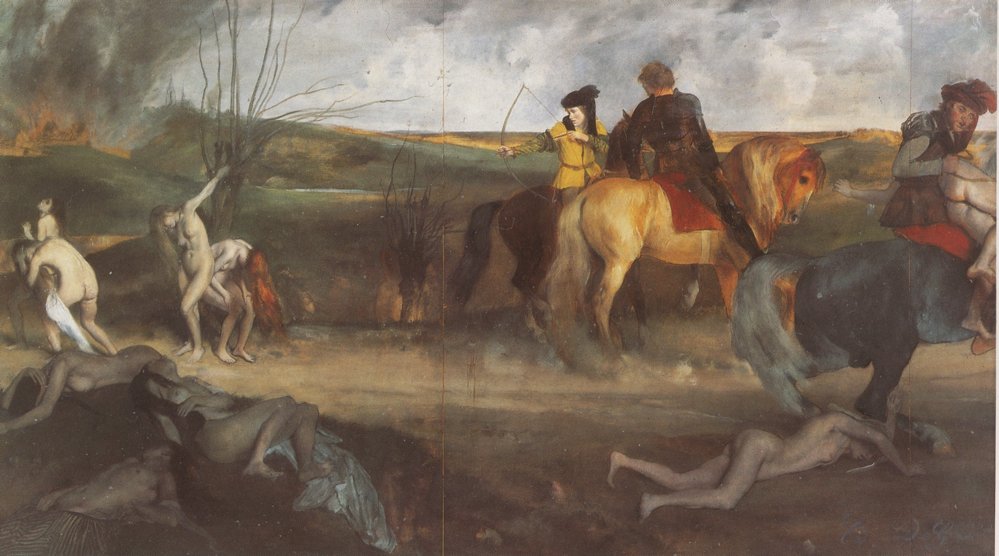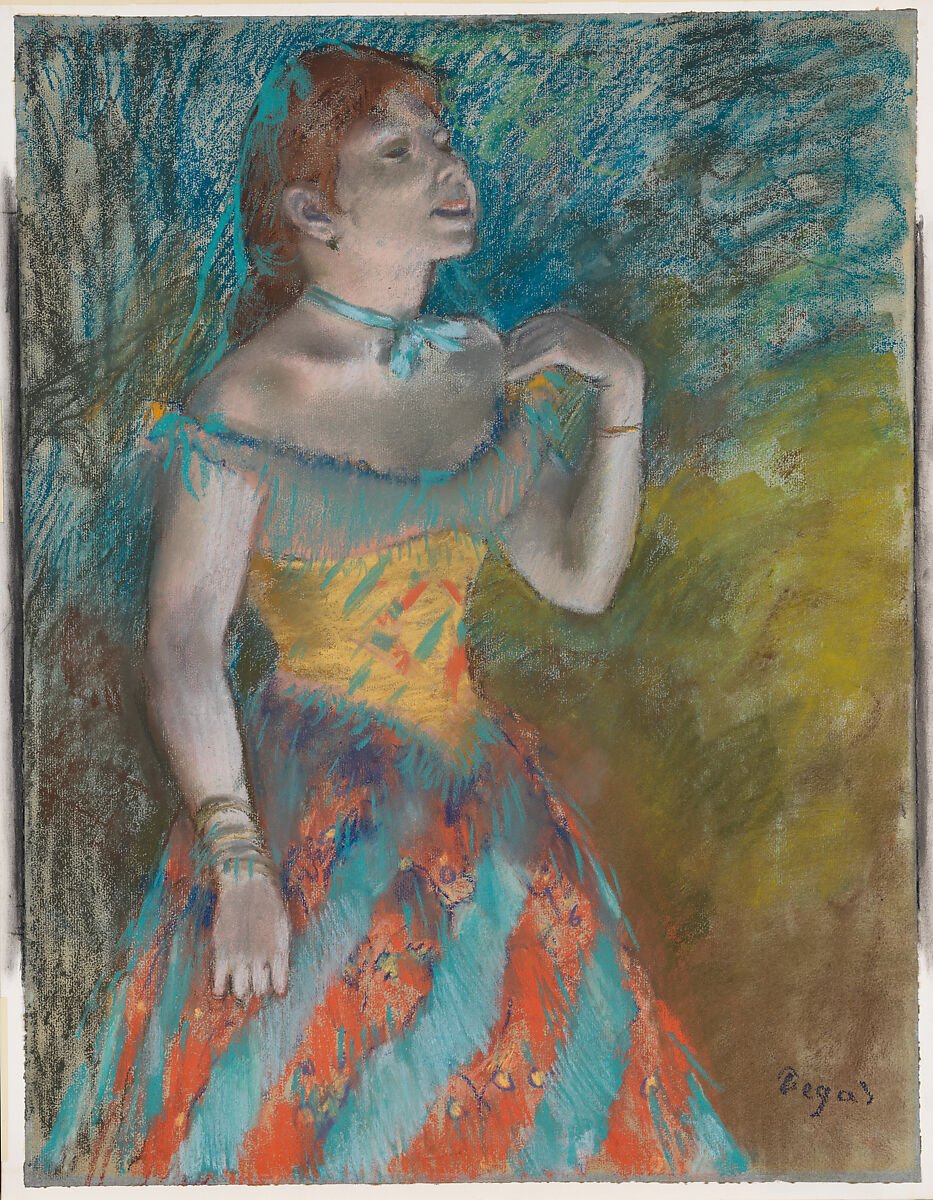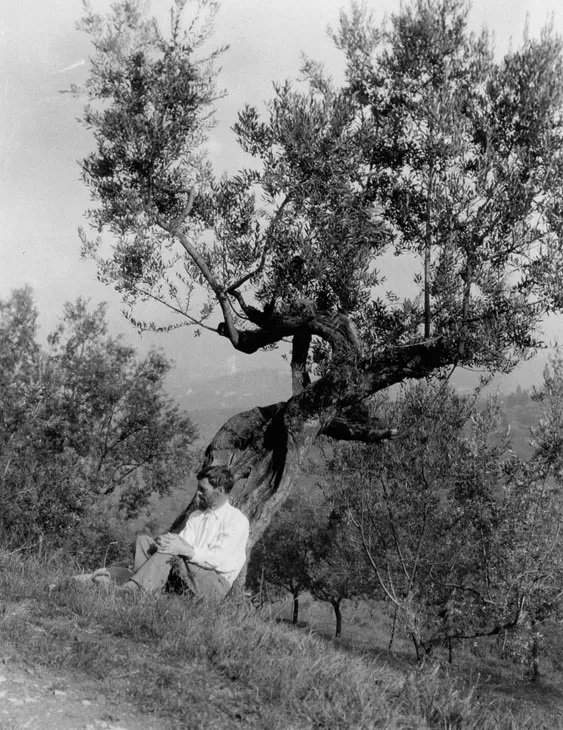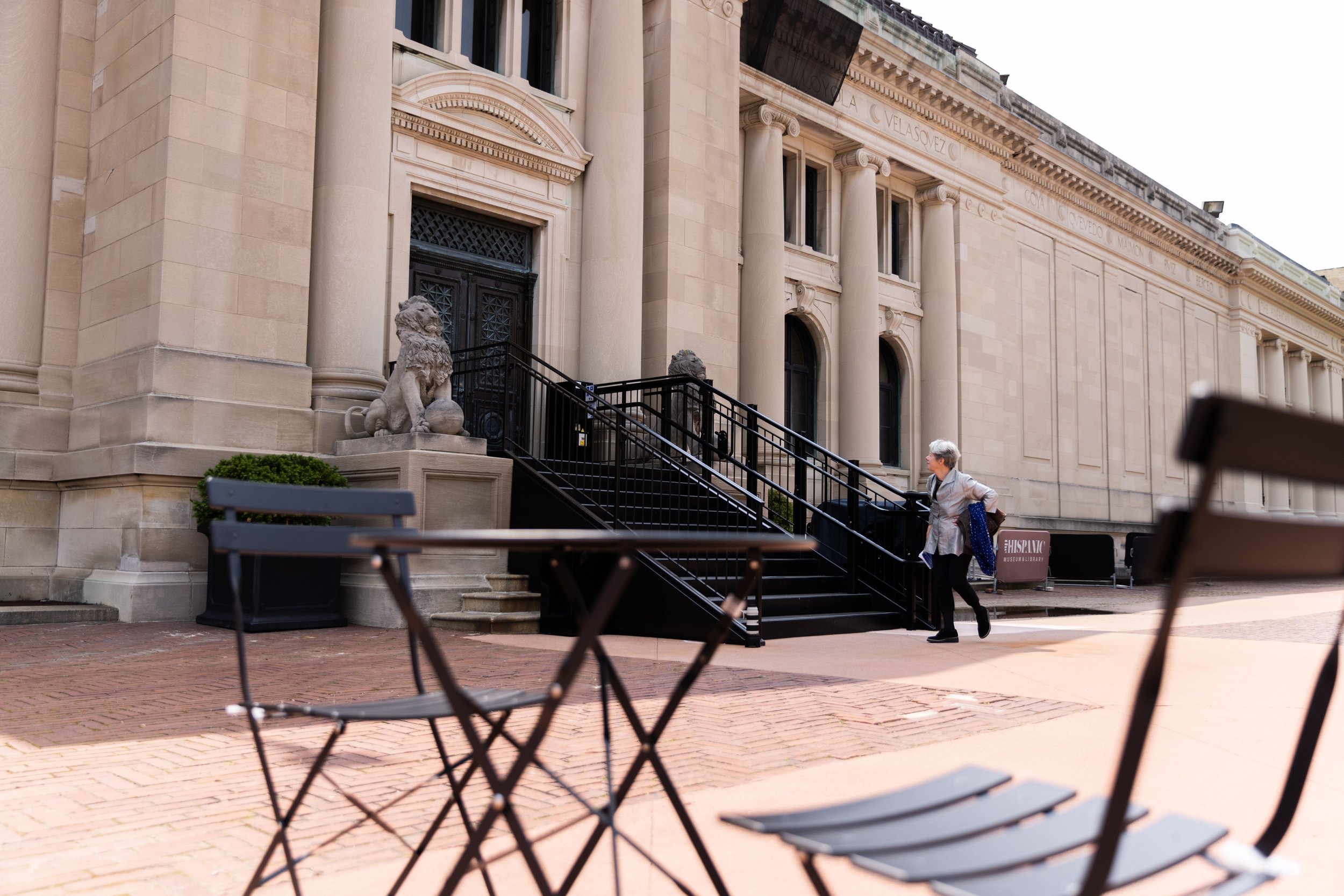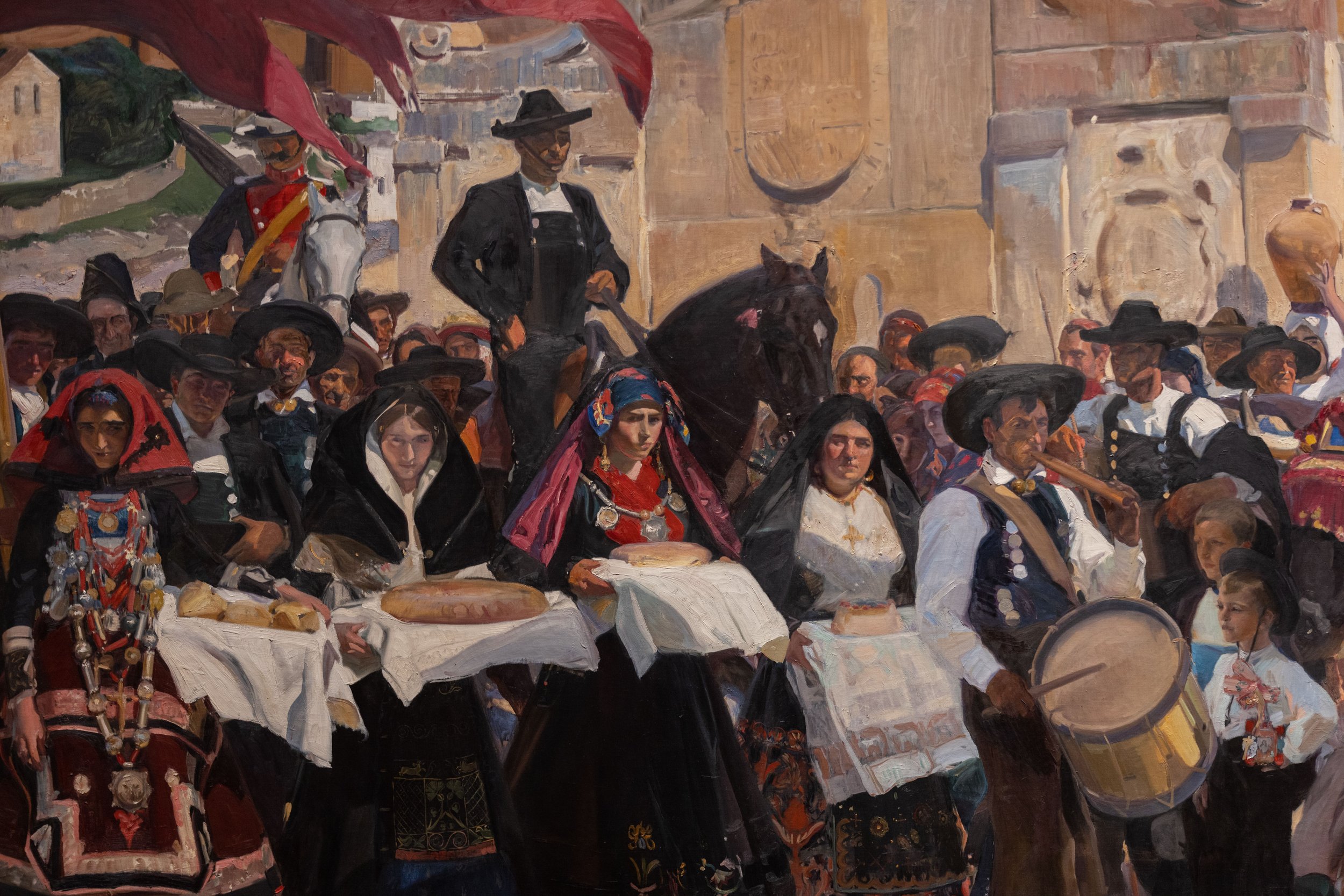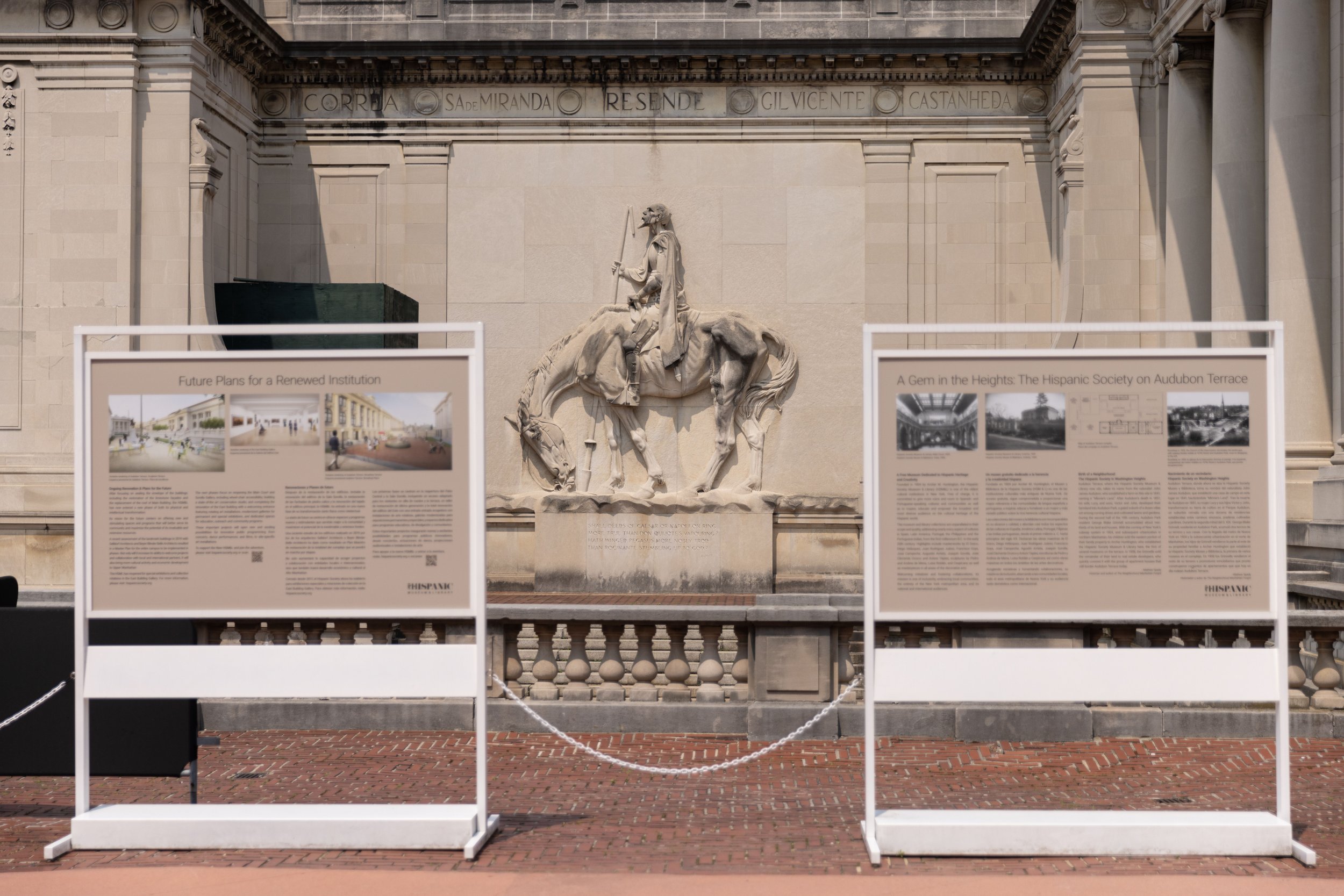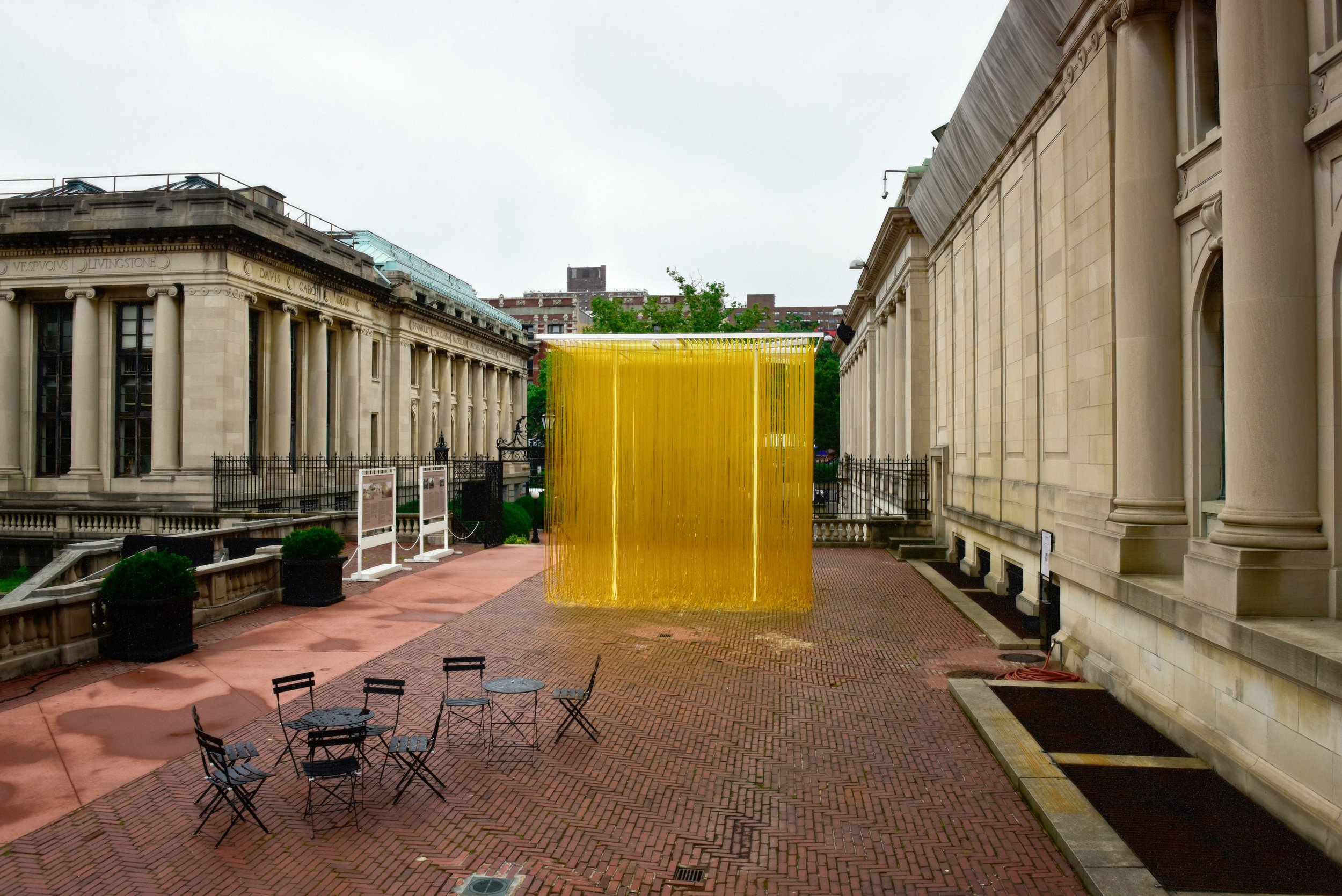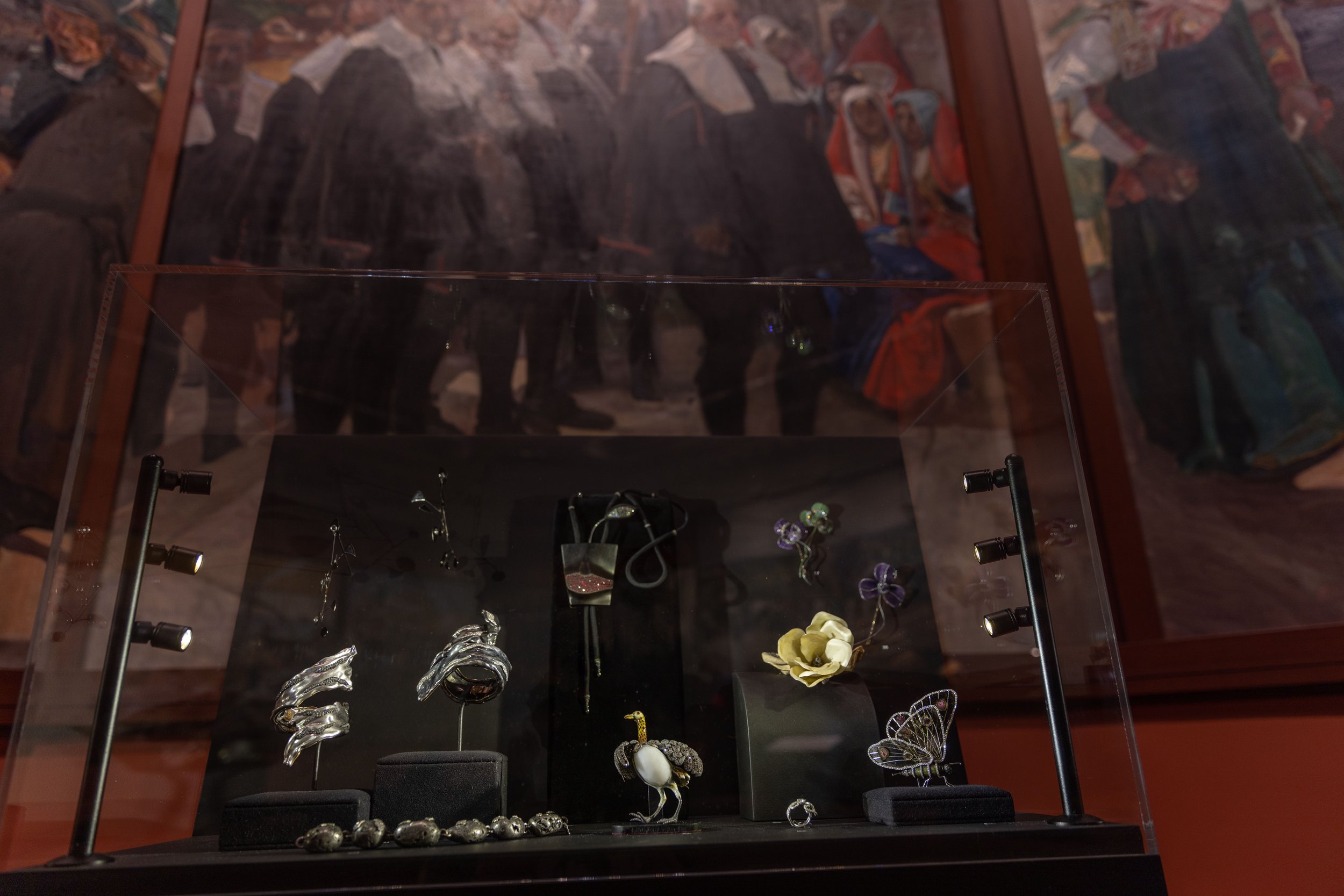THE NEW CRITERION, November 2023
On “Manet/Degas” at the Metropolitan Museum of Art, New York.
Manet Slash Degas. That’s the title of the double headliner now at the Metropolitan Museum of Art.1 It might as well be a statement. A physical slash runs clear through the middle of the exhibition’s title wall, dividing the names of the two artists. Similar slashes appear in various corners of the show, digging beneath the paintings and even cutting openings into other galleries.
If “Manet/Degas” is a slasher show, another clue is one of the first works on display. Edgar Degas painted Monsieur and Madame Édouard Manet (1868–69, Kitakyushu Municipal Museum of Art) as a gift to his artist friend after one of their weekly salons. The portrait depicts Monsieur Manet reclining on a sofa as he listens to Madame at the piano. But what we see today is only a partial view of the pair. Unhappy with Degas’ depiction of his wife, Manet slashed the right side of the canvas. When Degas discovered the defacement, he took the painting back and returned his own gift from Manet, a small still life of a bowl of fruit, over the insult. Degas then displayed the damaged portrait in his home, eventually next to Manet’s The Ham (ca. 1875–80, Glasgow Life Museums); a carving knife rests prominently in the foreground of that still life. Manet Slash Degas.
Edgar Degas, Monsieur and Madame Édouard Manet, 1868–69, Oil on canvas, Kitakyushu Municipal Museum of Art, Japan.
More evidence can be found in the many prints that inform this extensive, penetrating exhibition on the creative—and cutting—relationship between Édouard Manet (1832–83) and Edgar Degas (1834–1917). Since about half of the one hundred sixty works on display come from the collections of the Metropolitan and the Musée d’Orsay, the two organizing institutions of “Manet/Degas,” the Met’s extensive collection of works on paper helps fill in around Orsay’s blockbuster loans.
Printmaking is itself a slashing art. To make an etching, a needle must dig into a copperplate coated with an acid-resistant ground. When the plate is then submerged in acid, the groove exposes the copper to the bath, incising a line beneath. With drypoint, another intaglio printmaking technique, a needle is directly slashed into the plate, leaving a burr of metal that results in a fuller, fuzzier line when inked and printed on paper. Manet and Degas used both methods, sometimes combining the two in a single print.
Edgar Degas, Monsieur and Madame Édouard Manet, 1868–69, Oil on canvas, Kitakyushu Municipal Museum of Art, Japan.
Manet first met Degas in a gallery of the Louvre as Degas was creating just such a printing plate based on a Portrait of Infanta Margarita Teresa, today attributed to the workshop of Diego Velázquez. Rather than printing from a preparatory study, as was customary, Degas was taking the radical step of drawing with his needle directly from observation, attacking the plate in a riot of zig-zagging lines. “How audacious of you to etch that way, without any preliminary drawing. I would not dare do the same,” Manet supposedly said to Degas.
The Irish novelist George Moore said the relationship between Manet and Degas—equally ambitious Parisian artists, nearly the same age, and from similarly wealthy and cultured backgrounds—was “jarred by an inevitable rivalry.” As they absorbed the history of art by copying in the public galleries of the Louvre, in particular the Spanish and Italian masters, their relationship first played out in print. Degas created drawings and prints of his friend, including a suite of portraits of Manet sitting, leaning, and brooding in two-thirds profile circa 1868. Their relationship on paper continued long after Manet’s untimely death at age fifty-one. As Degas outlived his friend by over thirty years, he became a foremost collector of his work, even amassing a near-complete run of Manet’s prints.
An illuminating arrangement of prints here from 1861–62 includes the very study by Degas of the infanta over which the artists met, with an impression now in the Metropolitan’s collection. Directly facing this print is Manet’s own version after Velázquez, also from the Met. The copperplate of Manet’s etching, on loan from Paris’s Bibliothèque de l’Institut national d’histoire de l’art, is displayed between them. It is telling that the two artists’ versions are reflections of one another, literally and figuratively. Degas’ direct etching process resulted in a mirror image when printed. Manet, who made his prints from studies, maintained the orientation of the original in his impressions.
Edgar Degas, Scene of War in the Middle Ages, ca. 1865, Oil on paper mounted on canvas, Musée d’Orsay, Paris.
Through much of his career, Manet relied on printmaking to disseminate the images of his bold paintings and drawings. Degas, meanwhile, used the medium more as a space for experimentation. We can see the differences in these two infantas. Manet’s version looks like a reproduction, and a hasty one at that. Degas’ print goes off in its own unexpected direction. The free line of the needle takes on a life of its own. The lace of the infanta has been elaborated with an extra round of drypoint. That the Metropolitan has positioned the infantas on one of those slashed gallery walls underscores the central role of printmaking in the two artists’ relationship.
As the careers of the two artists developed in the 1860s, Degas had more to work through than Manet, who seems to have known what to do from the very start. Stephan Wolohojian, the Metropolitan’s John Pope-Hennessy Curator in Charge of the Department of European Paintings, has co-organized this exhibition’s stateside appearance along with Ashley E. Dunn, the museum’s Associate Curator in the Department of Drawings and Prints. In their joint introduction to the exhibition catalogue, the two call Manet and Degas “friends, rivals, and, at times, antagonists” who “worked in conversation throughout their careers, from the time of their first meeting in the early 1860s.” On the exhibition’s opening morning, Wolohojian downplayed their competition, or at least our inclination to declare a victor of the rivalry, saying,
Many visitors will try to figure out which of these two is the better artist. But this is not a competition between two of the greatest painters of the nineteenth century. There is no game. There are no rules. So there can be no winner.
And yet, out of the gate, Manet is the clear frontrunner. The exhibition’s lavender walls play to his brighter palette, while Degas’ subtleties get lost in the murk. Manet also pulls his paintings right to the surface, with public themes and shocking compositions, while Degas presents an interior world that requires deeper reflection. And Manet often went big when Degas kept it small. In some of the rooms, Manet comes across as having taken up nearly all the wall space, with Degas barely holding on to a corner.
Édouard Manet, Olympia, 1863, Oil on canvas, Musée d’Orsay, Paris.
These differences are most pronounced in the display of their two entries into the Paris Salon of 1865. For Degas, it was Scene of War in the Middle Ages (ca. 1865, Musée d’Orsay), a strange concatenation of nude women, flowing hair, burning towns, and trampling horses. For the figures, Degas made studies of classical anatomy. This work may be an allegory of the American Civil War, in which members of Degas’ extended family fought for the Confederacy. Yet the whole does not equal the sum of its parts. With all the action off to the sides and even cut off by the edges, the composition is downright bizarre—a harbinger of Degas’ experimental inclinations. For the audiences of 1865, just as for those of us at the Metropolitan today, this work could not hope to compete for attention against Manet’s entry in that same salon: Olympia (1863–65).
That painting of a courtesan and her maid was a scandal when presented in 1865. With its fraught dynamics of sex and race, it still causes palpitations in 2023. That the astonishing work has now traveled beyond the walls of the Musée d’Orsay is itself nearly unprecedented; seeing it in person reveals just how much gets lost in reproduction. We can observe how Manet subtly accentuated the contrasts of skin tones, of bedding and background. Olympia’s red hair flows over her left shoulder in a way that tends to disappear into the background of copies. In person the forceful expression of the maid, presenting Olympia with a bouquet of flowers and a sideways glance, also reveals a deep cognizance of the dynamics of the situation. As if there were any doubt of another, unseen figure in the room, the hissing cat with its back arched, staring straight out, makes the viewer the complicit third person in the scene. (A cat’s curving tail, queue in French, is also a slang word for a part of the male anatomy.) Compared to Manet’s Reclining Nude, a preparatory study composed in red chalk (1862–63, Musée d’Orsay), with its figure rotating away, here Olympia is tumbling forward into our own space, practically sliding off her disheveled silk cushions. Her modeled hands are all that holds onto her bright flesh, while her spare jewelry ties her back to the picture plane. The work seems immediate and raw but was, in fact, carefully crafted as an homage to Titian’s Venus of Urbino (the pose, the bedspread, the maid, even the pet is there). Manet set up the scene with models in his studio, with Victorine Meurent as Olympia and Laure as her maid. Both models reappeared in his later compositions.
Édouard Manet, The Dead Toreador, 1864, Oil on canvas, National Gallery of Art, Washington, D.C.
Manet’s boldest paintings trafficked in this full-frontal treatment while tying his compositions to the masterpieces of art history. The figure in The Dead Toreador (probably 1864, National Gallery of Art, Washington, D.C.) lies in an abstract foreground, with his blood about to run off the dark canvas. Manet’s portrait of Émile Zola (1868, Musée d’Orsay) is practically collage, with the images on Zola’s wall—including a grisaille of Olympia—applied like stickers to the painting surface. For The Balcony (1868–69, Musée d’Orsay), a four-person portrait that includes Berthe Morisot and was inspired by Francisco Goya’s Majas on a Balcony, a green railing is all that holds the figures back from our own viewing space. Even Manet’s Déjeuner sur l’herbe, which scandalized Paris two years before Olympia (here represented by a copy on loan from The Courtauld Gallery, ca. 1863–68), was based on studies of Giorgione and, in particular, an engraving of the Judgment of Paris by Marcantonio Raimondi after a lost original by Raphael.
And where was Degas during all this time? Making his own studies of Raimondi, for one. He was also creating his own portraits, based off of his studies from the Louvre, but they were often compositionally skewed, such as that of James-Jacques-Joseph Tissot (ca. 1867–68, Metropolitan Museum of Art), who appears to be sinking into the middle of the picture. Degas was also painting false starts—or at least, The False Start (ca. 1869–72, Yale University Art Gallery), one of his many images from the racetrack. As Manet painted the explosive instance, Degas looked to the odd moment. When the artists went to the races, Manet depicted the horses head-on, in The Races at Longchamp (1866, Art Institute of Chicago), while Degas observed them from behind in Racehorses Before the Stands (1866–68, Musée d’Orsay).
Edgar Degas, Cotton Office in New York, 1873, Oil on canvas, Musée des Beaux-Arts de Pau, France.
Manet’s figures tumble out of his compositions, while Degas draws us in. As his choice of subject matter turned from history and allegory to the realities of modern life, Degas’ work also became uniquely absorbing. His Cotton Office in New Orleans (1873) depicts both the dealings of the cotton trade and the family business. A descendant of the French diaspora, Degas was a Louisianian on his maternal side—his mother’s family had left Saint-Domingue after the Haitian Revolution (1791–1804)—while his father’s family owned the De Gas bank of Naples, Italy, having fled from France during the Reign of Terror. The New Orleans cotton office in the painting was his family’s own, observed firsthand when Degas himself left Paris in 1871 following the siege of that city in the Franco-Prussian War. (Both Degas and Manet had manned the artillery in its defense.)
Degas packed his New Orleans composition with a depth of mundane activity, accounting for the many facets of a busy cotton-factoring firm: counting the bales, manning the books, reviewing the operation. Cropped in the foreground, Michel Musson, Degas’ uncle, inspects the cotton’s fibers with his fingers. Meanwhile, sitting in a chair in the middle of the room, Degas’ brother René leans back and reads from The Daily Picayune. Good work if you can get it. It is appropriate that this painting of modern life became the first work by Degas to enter the collection of a French museum, when the Musée des Beaux-Arts in Pau acquired it in 1878. Degas had come into his own. (In an unexpected twist, the first museum to acquire a work by Manet was none other than the Metropolitan Museum of Art, when it accepted Boy with a Sword [1861] and Young Lady in 1866 [1866] as gifts from the American collector Erwin Davis in 1889. At the time, the Metropolitan exhibited these two works as by an “eccentric realist of disputed merit; founder of the school of ‘Impressionistes.’”)
There is no doubt that, between the two, Manet always remained the painter of action. You can just about smell the gunpowder smoke in his maritime painting of The Battle of the “Kearsarge” and the “Alabama” (1864, Philadelphia Museum of Art), of an engagement of the American Civil War that was waged off the coast of Cherbourg, France. The firing of flintlocks still rattles the composition in The Execution of Maximilian (ca. 1867–68, The National Gallery, London). Manet never saw these scenes in person but rather combined eyewitness accounts with the precedents of art history to great effect. In the case of Maximilian, the Habsburg heir installed by Napoleon III to become emperor of Mexico but soon deposed by loyalists to Benito Juárez, Manet directly quoted Francisco Goya’s Third of May 1808.
Édouard Manet, The Battle of the USS “Kearsarge” and the CSS “Alabama,” 1864, Philadelphia Museum of Art, Pennsylvania.
All the while, Degas looked ever deeper to the inside of life—revealing interior spaces along with what seemed to be the inner thoughts of his figures. In The Dancing Class (ca. 1870, Metropolitan Museum of Art), the intimate assembly of young figures appears to interact only with themselves as they become lost in a turnout, fixing a shoe, or bending at the barre in fifth position. As Manet stayed sharp, Degas leaned into a sense of distraction and ill-focus. On the surfaces of his work, he took to pastels and an innovative handling of color and line to give his paintings a new impression, leading the way for the movement that took this name. Many of his most lasting innovations were still to come, including his experiments in wax sculpture and staged photography, which fall outside the timeframe of Manet’s life and are therefore not included in the exhibition. But in such gauzy works as The Singer in Green (ca. 1884), Woman Bathing in a Shallow Tub (1885), and Woman Combing Her Hair (ca. 1888–90), all coming from the Metropolitan’s collection, we see the development of the same wavy line that first appeared in Degas’ print study of the infanta some two decades before.
Edgar Degas, The Singer in Green, ca. 1884, Pastel on light blue laid paper, Metropolitan Museum of Art, New York.
This blurred, impressionistic vision gave the works of Degas a new intimacy. In this exhibition’s comparison between those two famous tippling figures, In a Café (The Absinthe Drinker) (1875–76, Musée d’Orsay) by Degas and Plum Brandy (ca. 1877, National Gallery of Art, Washington, D.C.) by Manet, both of which relied on the same artist model, Ellen Andrée, it is the work by Degas that takes top prize. The off-kilter perspective, the drooping eyes, and the distracted male companion all present a sense of isolation that Manet’s more sentimental portrait never could.
Edgar Degas, In a Café (The Absinthe Drinker), 1875–76, Musée d’Orsay, Paris.
But this is not a competition, as the curator Stephan Wolohojian makes clear. Nor is it really a story of slash and burn. One of the final works here is Manet’s painting of Maximilian from The National Gallery, London. Like that portrait of Monsieur and Madame Édouard Manet at the start of the exhibition, this too is fragmentary. After Manet’s death, the large composition was slashed apart and broken up into smaller works. It was Degas who tracked down the pieces and brought them together again. Much as Degas added a portion of canvas to the damaged right side of Monsieur and Madame Édouard Manet, here he also dedicated himself after Manet’s death to his friend’s reparation. Whatever divide existed between them was also their bond. That slash was ultimately a stitch bringing these two masters ever closer together.


